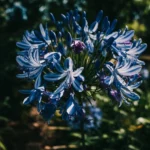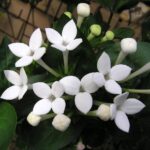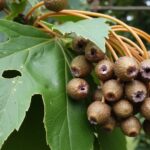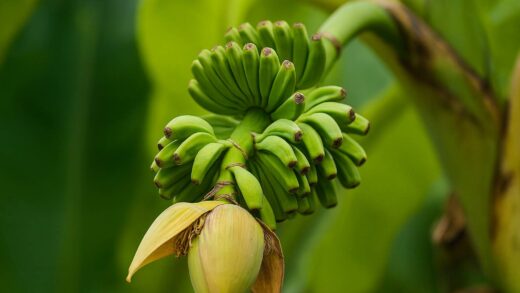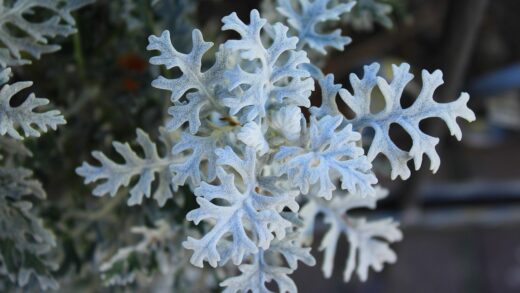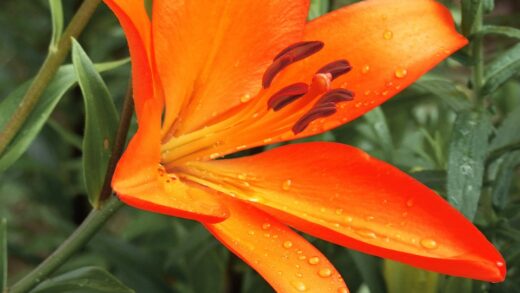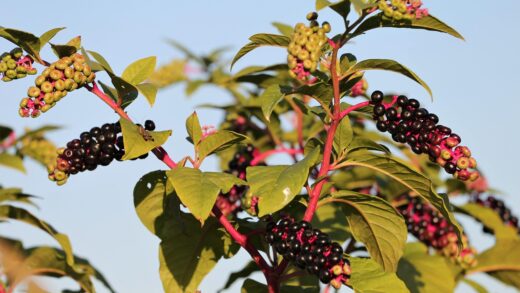Anemone hepatica thrives in a consistently moist but well-drained environment, a condition that perfectly mirrors the floor of its native deciduous forest habitat. The key to successful watering is achieving a delicate balance; the soil should never be allowed to become parched and dry, nor should it ever be waterlogged and saturated. Throughout the active growing season, from early spring through autumn, the plant requires a steady supply of moisture to support its foliage development and the formation of the following year’s flower buds. The period after flowering in late spring and early summer is particularly critical, as this is when the plant is photosynthesizing and storing energy. Inconsistent moisture during this time can lead to stress, reduced vigor, and diminished flowering in subsequent seasons.
The frequency of irrigation will depend heavily on several factors, including the local climate, soil type, and the specific location within the garden. In regions with regular rainfall, supplemental watering may only be necessary during extended dry periods. However, in drier climates or during periods of drought, regular irrigation will be essential. A good practice is to check the soil moisture by hand. If the top 2-3 centimeters of soil feel dry to the touch, it is time to water. This hands-on approach is far more effective than adhering to a rigid, predetermined watering schedule.
The type of soil plays a significant role in its water-holding capacity. A well-prepared soil rich in organic matter, such as leaf mold or compost, will retain moisture for longer periods while still allowing excess water to drain away. In contrast, sandy soils will dry out very quickly and require more frequent watering, while heavy clay soils can retain too much moisture and increase the risk of root rot. Amending the soil properly at the time of planting is therefore the first and most crucial step in managing the water needs of Anemone hepatica.
When watering is necessary, it is best to do so deeply and thoroughly, allowing the water to penetrate the entire root zone. Light, frequent sprinkling that only wets the surface of the soil is ineffective and can encourage shallow root growth, making the plant more susceptible to drought. Using a soaker hose or drip irrigation system can be an efficient way to deliver water directly to the soil, minimizing evaporation and keeping the foliage dry, which can help prevent fungal diseases.
Watering during the growth cycle
The water requirements of Anemone hepatica fluctuate throughout its annual growth cycle. In early spring, during flowering, the soil is often naturally moist from melting snow and spring rains. However, if the spring is unusually dry, supplemental watering may be needed to support the blooms and emerging foliage. The plant is most actively growing after the flowering period, and this is when its demand for water is at its peak. Consistent moisture from late spring through summer is crucial for the health of the leaves and the development of next year’s flower buds.
More articles on this topic
As the plant transitions into late summer and autumn, its water needs gradually decrease as growth slows down. However, the soil should not be allowed to dry out completely. A moderate level of moisture should be maintained until the ground freezes. Anemone hepatica, especially the evergreen varieties, can suffer from winter desiccation if it enters dormancy in a dehydrated state. A final deep watering in late autumn, before the first hard freeze, can be very beneficial, particularly in dry climates.
During the winter, the plant is dormant and its water requirements are minimal. In most climates, natural precipitation in the form of rain or snow will provide sufficient moisture. The primary concern during winter is not a lack of water, but rather an excess of it. Waterlogged, frozen soil can be fatal to the roots. This is why excellent drainage is so critical. A protective layer of mulch, such as shredded leaves, can help insulate the soil, preventing the damaging freeze-thaw cycles that can heave the plant out of the ground.
When spring arrives and the ground thaws, the cycle begins anew. It is important to monitor the soil conditions as the plant breaks dormancy. If the winter was dry with little snow cover, the soil may be quite dry, and an early spring watering may be necessary to rehydrate the plant and support the emerging flowers. Careful observation of the plant and the surrounding soil conditions is the best guide to providing the right amount of water at the right time.
Signs of improper watering
Anemone hepatica will provide clear visual cues if it is receiving either too little or too much water. Under-watering, or drought stress, will often manifest as wilting or drooping leaves. The edges of the leaves may turn brown and crispy, and in severe cases, the entire leaf may yellow and die back. A plant that is consistently under-watered will show stunted growth and produce fewer, smaller flowers in the following season. It is important to respond to these signs promptly with a deep and thorough watering.
More articles on this topic
Conversely, over-watering is a more dangerous and often irreversible problem. The primary symptom of excessive moisture is root rot, which occurs when the roots are deprived of oxygen in waterlogged soil. Above ground, the plant may exhibit symptoms confusingly similar to under-watering, such as wilting and yellowing leaves. This is because the rotting roots are no longer able to absorb water and nutrients. The base of the plant may also become soft and mushy, a clear indication of rot.
To differentiate between the symptoms of under- and over-watering, it is essential to check the soil. If the leaves are wilting but the soil is bone dry, the problem is a lack of water. If the leaves are wilting and the soil is soggy and saturated, the problem is too much water. In the case of over-watering, the only remedy is to improve the drainage. This may involve carefully lifting the plant, amending the soil with more grit and organic matter, and replanting in a slightly raised position.
Preventing watering problems is always preferable to curing them. This begins with proper site selection and soil preparation to ensure excellent drainage. Subsequently, adopting a mindful watering routine based on the actual needs of the plant rather than a fixed schedule is crucial. By regularly monitoring the soil moisture and observing the plant’s condition, a gardener can maintain the ideal moisture balance that Anemone hepatica requires to thrive.
The role of mulch in moisture retention
Mulching is an indispensable practice for managing the water needs of Anemone hepatica. A layer of organic mulch, 2 to 3 centimeters deep, applied to the soil surface around the plants, acts as a barrier, slowing the rate of evaporation. This keeps the soil cooler and more evenly moist for longer periods, significantly reducing the frequency of supplemental watering required, especially during hot and dry summer months. It creates a more stable root environment, protecting the delicate roots from temperature extremes.
The best types of mulch for liverworts are those that mimic the natural litter of a forest floor. Shredded leaves, particularly from oak or beech trees, are an excellent choice as they break down slowly, enriching the soil with valuable humus. Pine needles, fine bark chips, or compost can also be used effectively. It is important to avoid heavy, dense mulches that can mat down and impede water penetration and air exchange.
When applying mulch, it is crucial to keep it from being piled up against the crown of the plant. Direct contact between the mulch and the plant’s crown can trap too much moisture and lead to rot. Leave a small, mulch-free circle directly around the base of the plant. The mulch should be replenished annually, usually in the autumn, as the old layer decomposes and integrates into the soil.
In addition to moisture conservation, mulching provides several other benefits. It effectively suppresses the growth of weeds that would otherwise compete with the liverworts for water and nutrients. As the organic mulch decomposes, it continually improves the soil structure and fertility, fostering a healthy environment for beneficial soil microbes. This holistic approach to soil management is fundamental to the successful, long-term cultivation of Anemone hepatica.
Special considerations for containerized plants
Watering Anemone hepatica grown in containers requires a different approach than for plants in the ground. The limited volume of soil in a pot dries out much more quickly, making containerized plants more susceptible to drought stress. The frequency of watering will be significantly higher, especially during warm and windy weather. It is not uncommon for potted liverworts to require watering every few days, or even daily, during the peak of summer.
The key to watering container plants is to be thorough. Water should be applied until it flows freely from the drainage holes at the bottom of the pot. This ensures that the entire root ball is saturated and helps to flush out any accumulated mineral salts from the potting mix. After a thorough watering, the pot should be allowed to drain completely. Never let the pot sit in a saucer of water for extended periods, as this will create the waterlogged conditions that lead to root rot.
The choice of container can also influence watering frequency. Porous materials like terracotta will lose moisture more rapidly through their walls than non-porous materials like plastic or glazed ceramic. While terracotta’s breathability is good for root health, it does mean that the gardener must be more vigilant about checking the soil moisture. Regardless of the material, adequate drainage holes are absolutely essential for any container used to grow Anemone hepatica.
Monitoring the potting mix is the most reliable way to determine when to water. The “finger test” is a simple and effective method: insert a finger into the mix up to the first or second knuckle. If the mix feels dry at that depth, it is time to water. Over time, a gardener will also learn the weight difference between a freshly watered pot and one that is dry. This sense of weight can be a quick indicator of the need for irrigation.








